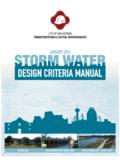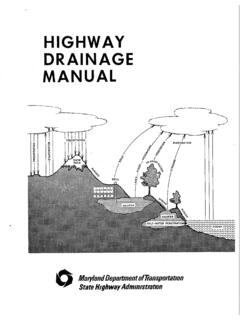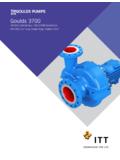Transcription of VOLUME 2 OF TENDER DOCUMENTS - National Centre for ...
1 VOLUME 2. OF. TENDER DOCUMENTS . Domestic Sewage Treatment Plant TECHNICAL SPECIFICATIONS. BILL OF QUANTITIES. AND DRAWING. for NCSCM. National Centre for Sustainable Coastal Management. Anna University Campus, Chennai Architects HVAC Consultant M/S. McD Built Environment Research Laboratory Pvt. Ltd. th #1354,9 cross,80 feet road, JP Nagar, 1St phase, Bangalore 560078. Phone: 080 41214020. PROJECT: NCSCM STP SPECIFICATIONS. DOMESTIC SEWAGE TREATMENT PLANT. 3. TECHNICAL SPECIFICATIONS. A. GENERAL. The main source of effluent is wastewater resulting from Toilet flushing and urinal flushing. The scope of work includes design , drawings, getting approvals from statutory bodies, construction, and erection and commissioning of domestic sewage treatment plant with electrical, mechanical and piping.
2 The treated effluent should be fit to reuse for AC make up in cooling towers. The work is required to be carried out on a turnkey basis covering a guarantee of satisfactory performance as per the standards laid for a minimum of one year. B BASIC DATA ON WASTEWATER (SEWAGE) (ASSUMED VALUES). Quantity : 200 KLD. pH : BOD5 @ 20 C : 500 mg/L. COD : 900 mg/L. TSS : 400 mg/L. Oil & Grease : 100 mg/L. C TREATED WATER QUALITY. Treated effluent quality shall be within the following values for various parameters, for typical reuse application of meeting Air conditioning make up water in cooling tower with water cooled Air conditioning system.
3 PH : BOD5 @ 20 C : 10 mg/L. COD : < 20 mg/L. E Coli : Nil Turbidity : 2 NTU. Oil & Grease : Nil Residual chlorine : 1 mg/L. D THE TREATMENT PLANT (STP). Based on the Raw Waste Water/ Treated effluent characteristics following treatment scheme is suggested: The raw effluent is led by gravity into a Bar Screen Chamber provided with MS Bar Screen. The screened effluent is collected in an equalization tank. This sump is provided to dampen the flow fluctuations and in order to keep the solids in suspension, pre aeration is provided with coarse bubble tubular diffusers. ARCHITECTS: FLYING ELEPHANT STUDIO 1 CONSULTANTS: McD BERL.
4 PROJECT: NCSCM STP SPECIFICATIONS. Sequential Batch Reactor (2 Nos). The sequencing batch reactor (SBR) process is a sequential suspended growth process in which all major steps occur in the same tank in sequential order. SBRs are a variation of the activated sludge process. They differ from activated sludge process because they combine all of the treatment steps and processes into a single basin, or tank, whereas conventional facilities rely on multiple basins. Basic treatment Process The operation of an SBR is based on a fill and draw principle, which consists of five steps . fill, react, settle, decant, and idle.
5 These steps can be altered for different operational applications. Fill: During the fill phase, the basin receives influent wastewater. The influent brings food to the microbes in the activated sludge, creating an environment for biochemical reactions to take place. React: This phase allows for further reduction or "polishing" of wastewater parameters. During this phase, no wastewater enters the basin and the mechanical mixing and aeration units are on. Because there are no additional VOLUME and organic loadings, the rate of organic removal increases dramatically. Settle: During this phase, activated sludge is allowed to settle under quiescent conditions no flow enters the basin and no aeration and mixing takes place.
6 The activated sludge tends to settle as a flocculent mass, forming a distinctive interface with the clear supernatant. Decant: During this phase, a decanter is used to remove the clear supernatant effluent. Idle: This step occurs between the decant and the fill phases. During this phase, a small amount of activated sludge at the bottom of the SBR basin is pumped out a process called wasting. Pressure Sand and Carbon Filter The process of passing the water through beds of sand or other granular materials is known as filtration. In this filter unit the water to be treated is passed under pressure. Broadly speaking, filters essentially consist of a thick layer of sand and the water is allowed to pass through it.
7 Pressure sand filters remove turbidity, suspended particles, colour and odour that are present in wastewater. Activated carbon is the most widely used substance for the removal of taste and odours, because it has excellent properties of attracting impurities, such as gases, finely divided solid particles and other liquid impurities. This filter unit also works in the same way as a pressure sand filter except for the fact that activated carbon is used in place of sand layer. Mechanical Filter Press ARCHITECTS: FLYING ELEPHANT STUDIO 2 CONSULTANTS: McD BERL. PROJECT: NCSCM STP SPECIFICATIONS. Filter presses are facilities developed for the mechanical liquid solid separation.
8 The Filter Press is ideal for sludge dewatering and slurry dewatering in small volumes. Using a feeding pump the suspension will be led into the filter press and against a liquid permeable filter cloth. During the process the retained solids form the sludge cake. Chlorine Dozer Chlorine is an effective disinfectant. The dosing of chlorine is carried out in a chlorine dosing tank. Provide metering pump dosing capacity 4 6 LPH with 25 liters capacity dosing tank. The excess sludge shall be pressed through an automatic hydraulic filter press and the cakes formed can be used as manure. Treatment Plant Units 1.
9 Bar screen chamber 2. Oil & Grease trap 3. Equalization tank 4. Pump Cum MCC Room 5. Sequencing Batch Reactor Tank 6. Decant Tank 7. Sand Filter & Activated Carbon filter 8. Chlorinator 9. Final treated effluent tank 10. Sludge holding tank 11. Filter press 12. Piping and cabling 13. LT power & Motor control panel E design criteria . The STP is designed on the basis of wastewater flow of 25 cum/day for quality parameters as in Para B & C where the contractor desire to submit alternate offers for STP, these values shall form the design criteria for alternate designs. Alternate design shall be submitted as separate offer.
10 Further following design criteria have been followed in the design of STP in this TENDER . Alternative, The Tenderer is requested to quote for STP with a SEQUENCING BATCH REACTOR. (SBR). Equalization Tank (Receiving Tank). Capacity of Tank : 63m3. SBR Feed pumps : 18 m3/hr @ 10m Head (2W+ 1S). Working hours : 12 Hrs ARCHITECTS: FLYING ELEPHANT STUDIO 3 CONSULTANTS: McD BERL. PROJECT: NCSCM STP SPECIFICATIONS. SBR Tanks 2 nos F: M Ratio : MLSS : 4000 mg/lit Oxygen requirement : 2 kg/ kg of the BOD. Decant Tank Detention time : hours based on hourly Flow of raw sewage. Filter Feed pumps : 10 m3/hr @ 30 m Head (1W+ 1S).


